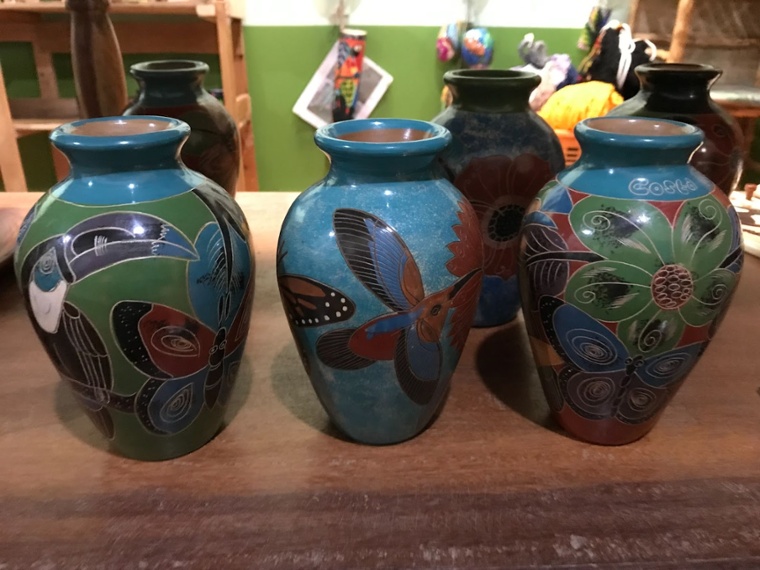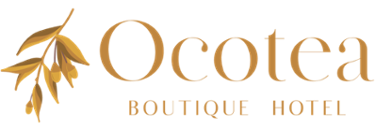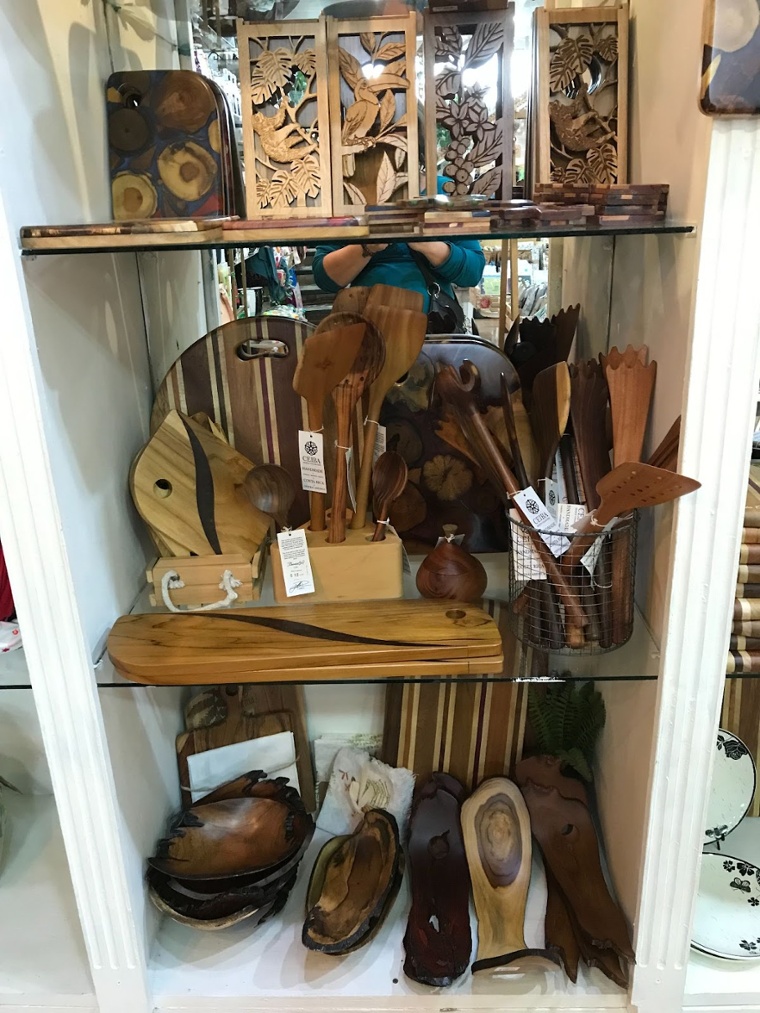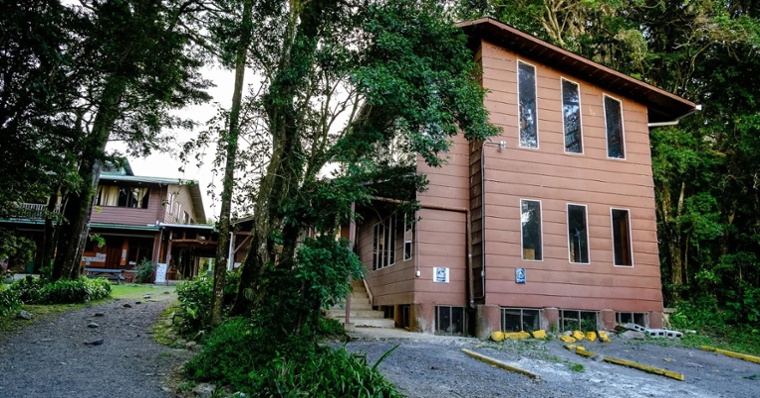Costa Rica- An Artisan's Paradise- Part 1

As an artist, I am continually in awe of the many amazing artisans that I’ve seen in Costa Rica. I have seen the most intricate paintings- done on a feather! I have seen jewelry made from slices of banana, and paintings so divine, they make me drool.
What’s truly unique about many of the arts and crafts here is the process behind their creation. Many of these skills have been passed down through generations, from a time before power tools… before electricity for that matter. They are painstakingly created using the most basic methods, and yet they are gorgeous.
There are eight indigenous tribes who make up the native population of Costa Rica, and many of these tribes have become specialists in certain types of crafts. Here are a few of my favourites.
The story of the Boruca mask is a violent one, sadly. During the time of the Spanish invasion of Costa Rica, the warriors of the Boruca tribe (located near southern Puntarenas) began carving masks out of balsa wood or cedar. The masks were carved to resemble devil faces and aptly named “Diablitos”. Native warriors would then rush the Spanish soldiers wearing nothing but the brightly painted devil’s faces.
The Spanish were, unsurprisingly, startled by the fierce (and naked) warriors, and decided that they must be devil worshippers. They left the tribe alone. The Boruca are the only local indigenous people never conquered by the Spanish. Today the masks are used in the Fiesta de los Diablos, a three day festival that reenacts the battles between Spanish and the Boruca Tribe, and celebrates their victory.

While many of the masks still wear devil faces, you can also buy “ecologica” masks which feature animals and plants of the rainforest,and “combinados” which blend the other two types together.
Jicara
The Jicara is the fruit of the calabash tree. It’s not an edible fruit, although the seeds are used to make horchata, which is a creamy local drink. The outer casing of the jicara is so hard that when I first saw one and decided I wanted to know what was inside- I couldn’t even break it open by smashing it on the pavement. I actually had to use a saw to get into it.
I asked around and found out that the jicara (pronounced with a hard H sound) has been used for everything from bowls to spoons to jewelry. The shell is cut open, the soft center is scooped out and the shells are left to dry in the sun. As they dry, the shells turn brown and look like smooth coconuts. They are then cut and carved and into whatever imaginative artisans can think of. They are often painted with colourful animals.
I’m in the process of experimenting with my own Jicaro craft. Mine will be a lampshade!
Bowls made from jicaro are known as guacales. You can also find locally made glasses, spoons, napkin holders, earrings, belt buckles, hair ornaments and bracelets.
Chorotega Pottery
In the town of Guaitil an hour from Tamarindo, you will find the Chorotega Tribe. They are world famous for their beautiful pottery. This is another skill that has been passed down through generations, and their art continues to be made with few modern tools and fired in handmade clay kilns.

The artisans sell their pottery world-wide and this helps them maintain their traditions. The link above actually leads to Spanish Schools in Costa Rica where you can learn all sorts of cool things - including how to make traditional Chorotega pottery!
It’s quite a process since the raw clay has to be removed from the earth, pulverized into a powder using a wooden mortar and then mixed with precise amounts of river water and “iguana sand” to get the right consistency for the pots.
Painting
You can find artists and artisans all through Costa Rica who create gorgeous paintings, and painted crafts, but I would like to concentrate on the Maleku Tribe… because they need our help!
This indigenous tribe is the smallest with only 650 people left. They currently reside about an hour north of La Fortuna, which is near Arenal Volcano.
Their reservation, and their traditional lifestyle are both in danger, due to the loss of much of their land. They create beautiful painted items to sell to tourists, and the sale of crafts helps support many of the villagers, as well as their way of life.
These painted pieces also act as a dictionary of the Maleku language, having the Maleku word for the animals they represent written on the pieces to help keep their language alive.
How cool is that?
You can also help by taking a tour of the village while you’re here. Your tour will include a history lesson, a trip through the reforestation project that the village has undertaken, a traditional Maleku lunch, and ceremony... and a chance to paint your own craft! Your $65 will provide you with 3+ hours of fun, and the people of Maleku with hope for the future.
You can also take a night tour to see all the cool nocturnal critters that only appear when the sun goes down. That tour is just $45 and lasts two hours.
Tell all your friends! You can also go to either of the above links and follow the prompts to donate to the village.
I’d like to point out that the pic above is actually painted jicara! In many places you will see them cut in half, painted and put back together to create little purses!
I’m itching to head over there and play with some paints, and then go learn to make pottery. Most definitely on my to-do list!
Huetar Tribe
Located on the Quitirrisi Reserve near the Central Valley, the Huetar Tribe are known for creating handwoven baskets and straw hats out of paja reeds and leaves from the palm tree and liana bush. The paja reeds are laid in the sun to dry for about a week, at that point they are supple enough to weave.
In some cases the reeds are dyed bright colours first by boiling them for three hours with natural dyes from berries and plants.
The finished products are intricately beautiful like the items above. You can visit El Collectivo to learn more.
And We’re Just Getting Started!
Here in Monteverde, you can also find a nice collection of handmade crafts, as well as a restful garden in which to relax and sip a dark, rich cup of coffee at The Monteverde Art House just outside of town.
Or visit a truly amazing mural artist who paints everything from skateboards to bikinis as well colourful paintings.
Soon, we’ll be breaking down some more of the incredible Costa Rican artwork. In the meantime, I’m going to go play with my jicara. Stay tuned for part 2 of Costa Rica-An Artisan’s Paradise when we learn about wood carving, fabric art, carretas and more!
Until then… Pura Vida!





